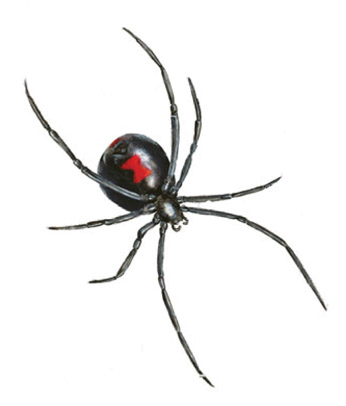

Order: Araneae (Spiders)
Size: Up to ⅜" (females larger than males)
Range: Throughout the United States
Habitat: Dark, hidden areas in woodpiles, sheds, debris
The Black Widow is one of the most feared spiders due to its secretive but dangerous nature. Although their bites are rarely fatal, they can cause serious illness. The female is glossy black with a large, rounded abdomen; medium-length legs; and a bright red, hourglass-shaped spot on her underside (this may appear as two separate red lines divided by black). The male has a much smaller body but relatively long legs and is paler in color with dull reddish marks on his abdomen. Both sexes are capable of injecting venom, but the female gives a larger volume. They feed on insects or other spiders that become ensnared in their webs, whereby they wrap the prey in silk and ingest the juices. Oftentimes the female will eat the male after mating. The underside of the female is illustrated.
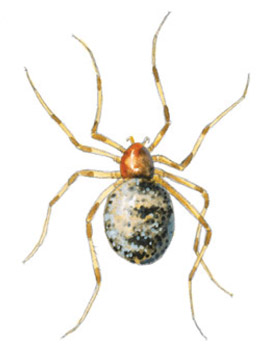
Order: Araneae (Spiders)
Size: Up to ¼" (females larger than males)
Range: Throughout the United States
Habitat: Houses, barns, sheds, and other buildings
This common spider is a member of the group known as “cobweb weavers” or “comb-footed spiders” because of the irregular webs they weave and the presence of comb-like bristles on the ends of the hind legs. As with most spiders, the American House Spider has a small cephalothorax (head and thorax combined) that bears four pairs of walking legs and a larger, bulbous abdomen (especially large in females). This spider has no antennae, and its mouthparts are flanked by a pair of small sharp fangs. Its color is light brown with variable blackish and gray patches and mottling on the abdomen. When prey is trapped in the web, this spider will encase it with extra silk and often carry it to another location to suck out the fluids. They generally avoid humans and run away or feign death if disturbed, but rough handling could result in a minor but painful bite. The female is illustrated.
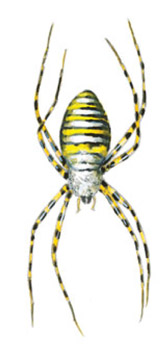
Order: Araneae (Spiders)
Size: Up to 1" (females larger than males)
Range: Throughout the United States
Habitat: Gardens, grassy fields, thickets
Also known as the Banded Argiope, this spider is in the group known as the “orb-weavers” because their webs are composed of round, spiraling rings of silk suspended between grasses and shrubs. Its abdomen is elongate and pointy at the rear. Its legs are fairly long and, when at rest, are held with the front two pairs forward and the back two pairs behind. Females have a creamy or yellow abdomen with thin black bands and a fuzzy, grayish carapace. Males are substantially smaller than females and have a pale gray, gold-speckled abdomen. The spider’s web is up to 2 feet across; it builds it early in the morning and subsequently eats it at the close of day. It makes a new web each morning. Banded Garden Spiders wait in the center of their web, head down, for any insects flying or jumping into it, whereby they wrap the prey in silk and suck out the juices. They can deliver a bite if harassed or if they sense that their eggs are in danger. The female is illustrated.
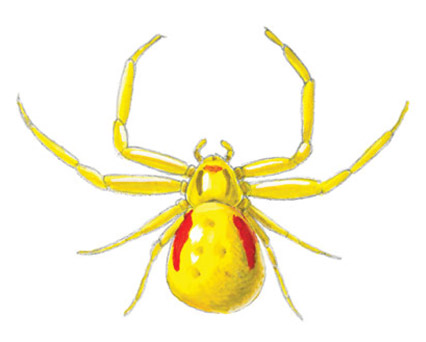
Order: Araneae (Spiders)
Size: Up to ⅜" (females larger than males)
Range: Throughout the United States
Habitat: Areas with flowering plants; gardens, fields
The Goldenrod Crab Spider is a member of the group known as “crab spiders” because it typically holds its legs out to the sides of its body, like crabs, and prefer to crawl sideways more than forward or backward. The first two pairs of legs are noticeably longer than the hind two and are held out for grasping prey. The color of its body can change to match its surroundings, from whitish to bright yellow (like the goldenrod flower), and there are usually red marks on either side of its abdomen and between its eyes. The male is smaller than the female, with a small abdomen but proportionately longer legs, and has a brownish body with a pale spot on the center of its carapace. This species is considered a “flower spider,” those that do not spin a web but climb onto plants and flowers waiting to ambush visiting insects (especially pollinators). Goldenrod Crab Spiders are harmless to humans. The female is illustrated.
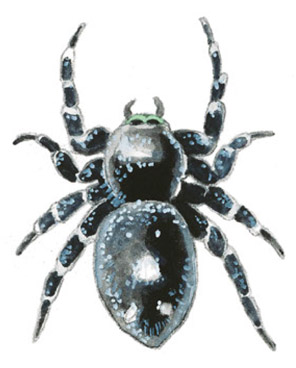
Order: Araneae (Spiders)
Size: Up to ⅝"
Range: Throughout the United States
Habitat: Gardens, fields, open woodlands
The jumping spiders are a group of small, hairy, compact, short-legged spiders with an incredible jumping ability. They also have four pairs of eyes, two of which are large and forward facing, giving them highly developed stereo vision. The Bold Jumping Spider is quite large for a jumping spider and is colored mostly black, with scattered white and gray markings (juveniles have orange on their abdomen). The chelicerae (front fangs) are iridescent bluish green. These spiders are active during the day, especially in bright light, when they can use their keen vision to locate prey. They set a silken tagline and leap at their victims, even those in flight. If the spider misses the target, it can climb its way back via the tagline. It eats insects and other spiders, even those much larger than itself.
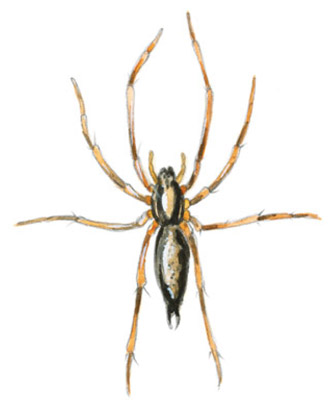
Order: Araneae (Spiders)
Size: Up to ¾"
Range: Throughout the United States
Habitat: Gardens, grassy fields
The grass spider, several species of which exist in North America, is a member of the group known as “tunnel weavers,” who weave a flat web in grasses with a funnel-shaped section to one side, where the spider waits for prey. When a prey insect ensnares in the web, the spider scurries out to inject it with venom and carries it back into the funnel section to feed. Grass spiders are cryptically colored in browns and grays, with a light tan cephalothorax that has two darker brown stripes and a mottled gray, teardrop-shaped abdomen, which terminates in pointed spinnerets (the silk-producing organs). The legs are long and thin. Grass spiders are harmless to humans, being shy and retreating to safety when encountered.
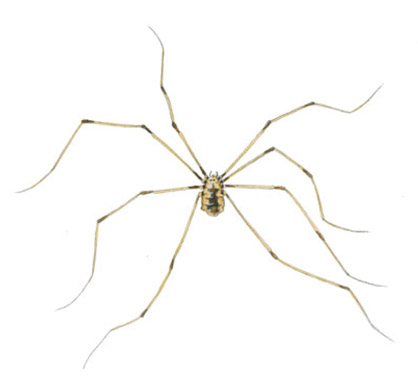
Order: Opiliones (Harvestmen)
Size: Up to ¼"
Range: Central and eastern United States
Habitat: Woodlands, gardens, shrubbery
These curious arachnids are not true spiders, but belong to a group known as harvestman spiders. Many species occur in North America, and most have a distinctive oval, flattened body with a broadly fused head, thorax, and abdomen and extremely long, thin legs. Despite the long legs, they are held bent and the body stays close to the ground. Like spiders, harvestmen have eight legs, but the second pair is longer than the others and is often used in sensory perception. Striped Daddy Long-legs have a pale body with dark stripes down their back and blackish legs. They feed on decaying plant material or small insects and will often congregate in clusters on the warm sides of buildings or tree trunks. Contrary to some myths, harvestmen have very small feeding pincers, are nonvenomous, and are completely harmless to humans. They easily break off a leg in self-defense that will not regenerate.
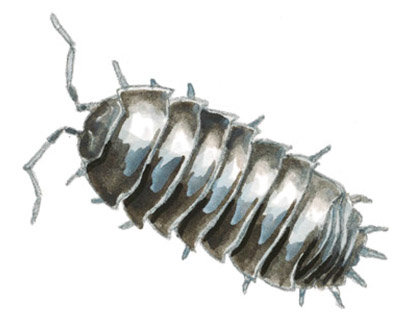
Order: Isopoda (Sow Bugs and Allies)
Size: Up to ½"
Range: Throughout the United States
Habitat: Moist places under rocks and logs; gardens, woodlands
The large group of invertebrates that includes sow bugs (also known as “wood lice”) are not insects but crustaceans, being related to the crabs and lobsters. They are small and oblong, with a flattened carapace composed of several segments. They have seven pairs of legs of nearly equal length; tiny, simple eyes; and two taillike projections (uropods). Their color is some shade of gray or brown. Some species can roll their bodies into a tight ball and are known as “pill bugs” or “roly-polies.” Sow bugs stay in secluded, dark, damp places during the day and venture out at night to feed on plants, leaves, and decaying organic matter with chewing mouthparts. The eggs are carried in brood pouches on the underside of females and hatch to young that look like miniature adults.
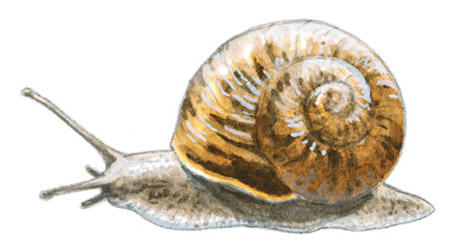
Class: Gastropoda (Snails and Slugs)
Size: Shell 1¼" diameter
Range: Throughout North America
Habitat: Shady or moist areas, gardens, croplands
Garden Snails were introduced from Europe and are now widespread in North America. This is the snail you are most likely to see in your garden. The body is like a gray slug with a thin, spiraled, brown shell with darker brown or black bands and striations. When the snail is active, the long foot, head, and two sets of tentacles are extended, but the soft parts quickly retract into the shell if threatened. During very dry weather snails can survive by contracting into their shell and sealing their bottom with mucus. They are mostly active at night or during the day during wet weather, feeding on a wide variety of plants with a rasping tongue. Though these are not the typical snail used as escargot in cuisine, they are still edible and considered a delicacy by some.
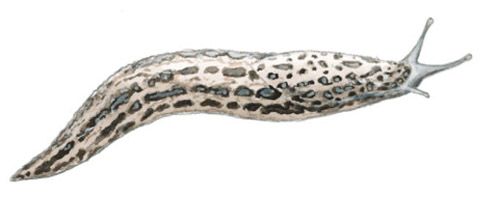
Class: Gastropoda (Snails and Slugs)
Size: Up to 6"
Range: Throughout North America
Habitat: Woodlands, gardens, urban areas
Also known as the “spotted garden slug,” this species is indigenous to Europe but is now common and widespread in North America and is the slug you are most likely to see under rocks and scraps of wood in your backyard. Its body is grayish or brown, with black “leopard spots” on the mantle and broken black lines along the sides and lower back. The slug has a long, muscular foot and two sets of retractable tentacles on its head that it uses for smelling and light detection. The posterior of its body is wrinkled and slightly keeled. Leopard Slugs feed on plants, decaying organic material, and mushrooms and are sometimes pests in gardens. They lay a mass of clear, round eggs that develop directly into small slugs. Active at night, they become dormant in times of dry weather.

Class: Gastropoda (Snails and Slugs)
Size: Up to 6"
Range: Pacific Northwest
Habitat: Moist fields, gardens
The Black Slug is a large slug introduced from Europe and is now common in the northwestern United States. The body is elongate and broad, with a rounded back and blunt tail section. The front half of the body is topped by a raised mantle covered in small tubercles, while the back half has long, linear ridges. As with other slugs, the Black Slug has a pair of long, light-sensing tentacles; a pair of shorter smelling tentacles; and a tough foot that runs the length of its underside for locomotion. The color of its mucous-covered skin is generally jet black, but variants may be whitish or brownish. Young slugs are colored tan or reddish but attain darker colors with maturity. Black Slugs are active mostly during the wetness and coolness of night, feeding on plants, fungi, and decaying organic matter, and can be a pest to crops and gardens.
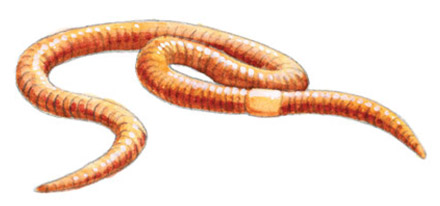
Class: Oligochaeta (Earthworms)
Size: ½–14"
Range: Throughout North America
Habitat: Moist soils and compost; under logs and rocks
The class of earthworms consists of well over a thousand species, but they all share a similar body plan even if their size varies considerably. Essentially, they are like segmented tubes, tapered at both ends, with a mucus-covered skin (cuticle) and very simple internal organs and sensory apparatus. They make tunnels through soil by pushing aside the soil or by ingesting it and expelling the remains behind (one can see little piles of these remains, called castings, near a tunnel entrance). For grip, they are lined with tiny, tough bristles that stick to the soil, and wavelike contractions move the body forward. All earthworms are very beneficial to soil health because they increase aeration and release partially digested organic matter that plant roots easily absorb. Earthworms reproduce by coupling together at an enlarged band (the clitellum) and produce small egg capsules. The Red Wriggler, Eisenia fetida, is illustrated.
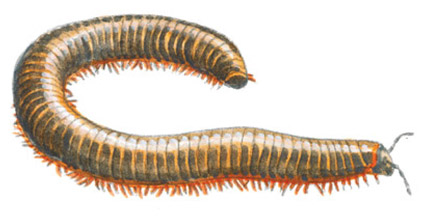
Class: Diplopoda (Millipedes)
Size: Up to 4"
Range: Throughout North Americ
Habitat: Under rocks and logs around moist soils and leaf litter
The familiar and friendly millipedes are part of a group of invertebrates known as myriapods, which also includes the centipedes. They have long, cylindrical or flattened bodies with many hardened, thin segments, most of which bear two pairs of tiny legs. The word millipede means “thousand legs,” and although this is an exaggeration, species with over a hundred legs are not uncommon (the record is 752 legs!). After hatching, most millipedes have only three pairs of legs, and with each molt more legs are added. They are relatively slow moving on land and mostly burrow through soil headed by a tough shield behind the head and propelled by the force of their many legs. Millipedes feed on decaying organic matter and plants and, like earthworms, are important for the health of soils. They do not bite or sting, thus are completely harmless to humans. In defense, they crawl away, twist into a compact spiral, or roll into a ball like a pill bug. The American Giant Millipede, Narceus americanus, is illustrated.
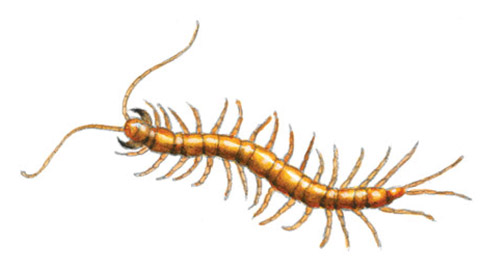
Class: Chilopoda (Centipedes)
Size: Up to 1¾"
Range: Throughout North America
Habitat: Under rocks and logs around moist soils and leaf litter
Centipedes are in the same group (myriapods) as millipedes, but they have only one pair of legs for each body segment (millipedes have two pairs per segment). The name centipede means “hundred legs,” but in actuality the amount can vary from just over a dozen to well over a hundred. Their body is highly segmented and flattened, allowing them great mobility and the ability to squeeze into tight areas. They run quite fast and use their tactile antennae as their key method of perception. Centipedes are very sensitive to desiccation, so they are restricted to moist areas and are normally active at night. They are predators on other invertebrates, including insects, spider, slugs, and worms, which they seize with venom-laced claws near the head. If handled roughly, they can give a painful but nonserious bite. The Stone Centipede, Lithobius forficatus, is illustrated.